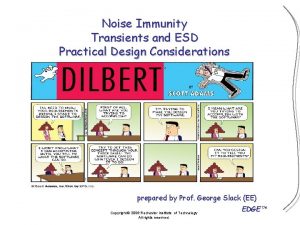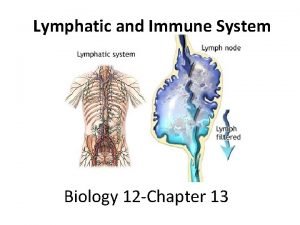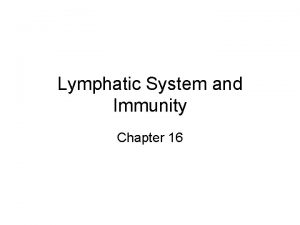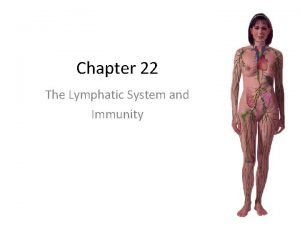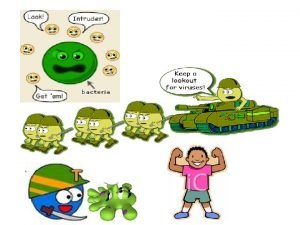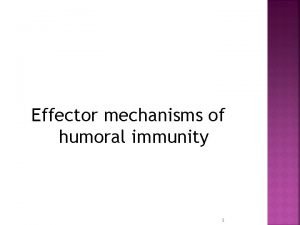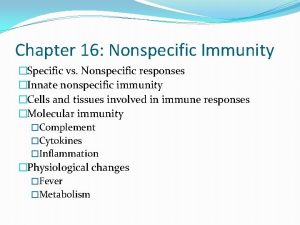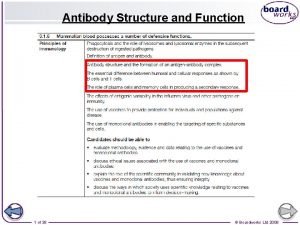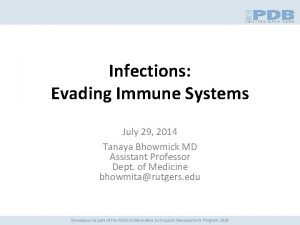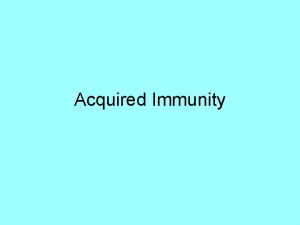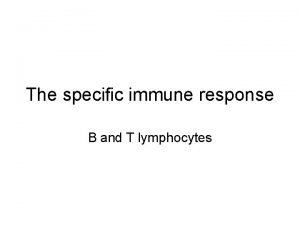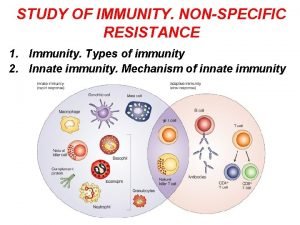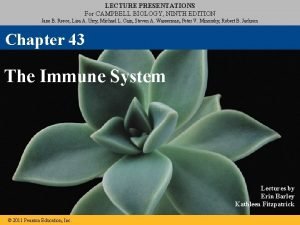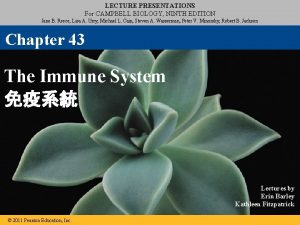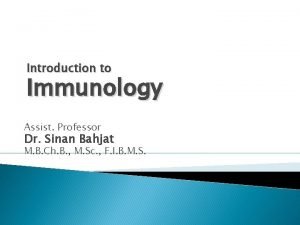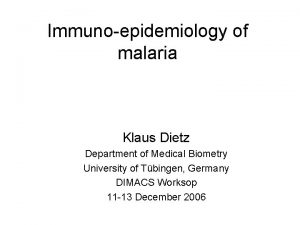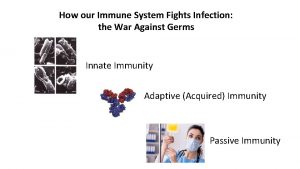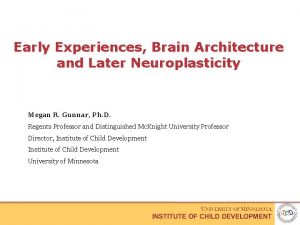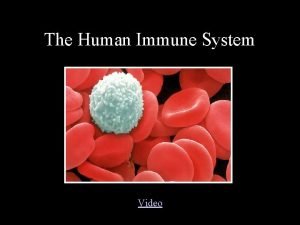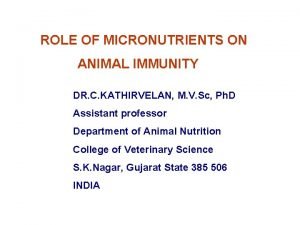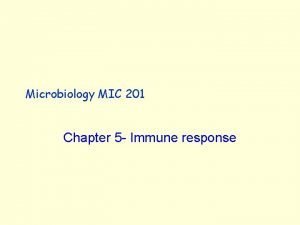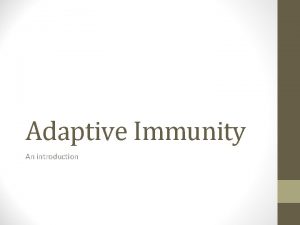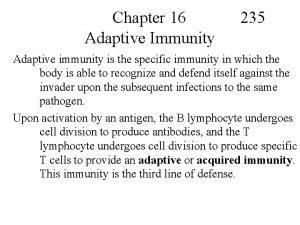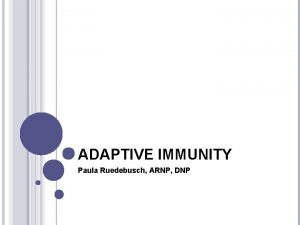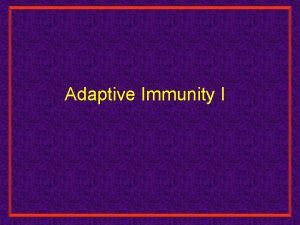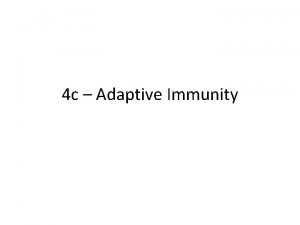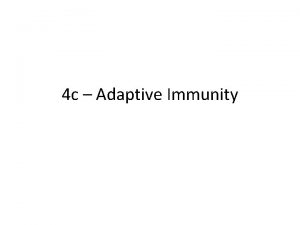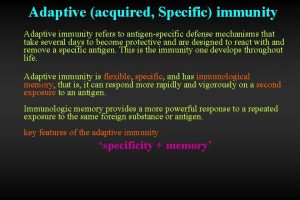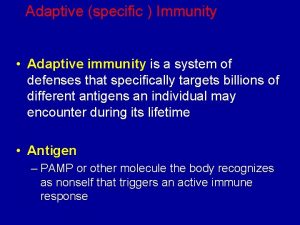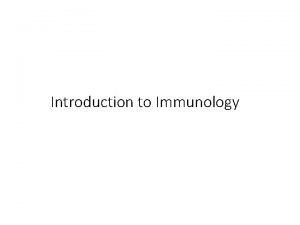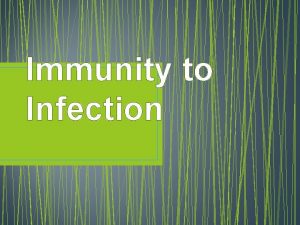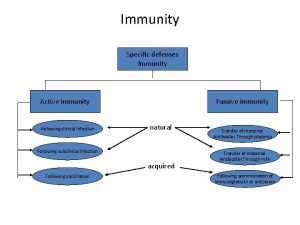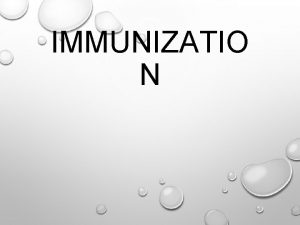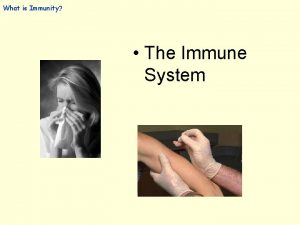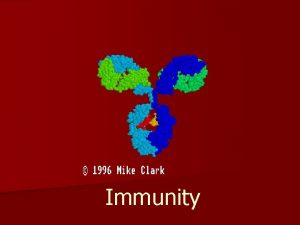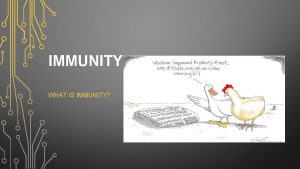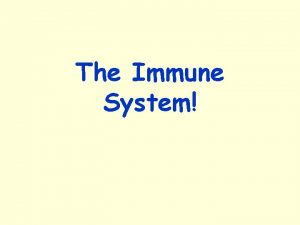Chapter 16 Adaptive Immunity Overview of Adaptive Immunity

















































- Slides: 49

Chapter 16 Adaptive Immunity

Overview of Adaptive Immunity Adaptive immunity is the body's ability to recognize and defend itself against distinct invaders and their products Five attributes of adaptive immunity Specificity Inducibility Clonality Unresponsiveness to self Memory

Overview of Adaptive Immunity Involves activity of lymphocytes Two main types of lymphocytes B lymphocytes (B cells) Mature in the bone marrow T lymphocytes (T cells) Mature in the thymus Two types of adaptive immune responses Cell-mediated immune responses Antibody immune responses

Host Defenses: The Big Picture PLAY Host Defenses: The Big Picture

Cell-Mediated Immunity: Overview PLAY Cell-Mediated Immunity: Overview

Humoral Immunity: Overview PLAY Humoral Immunity: Overview

Elements of Adaptive Immunity The Tissues and Organs of the Lymphatic System Composed of lymphatic vessels and lymphatic cells, tissues, and organs Screen the tissues of the body foreign antigens The lymphatic vessels and the flow of lymph Lymphatic vessels One-way system that conducts lymph from tissues and returns it to the circulatory system Lymph Liquid with similar composition to blood plasma Arises from fluid leaked from blood vessels into surrounding tissues

Elements of Adaptive Immunity The Tissues and Organs of the Lymphatic System - Lymphoid organs Primary lymphoid organs Red bone marrow Thymus Secondary lymphoid organs Lymph nodes Spleen Tonsils Mucosa-associated lymphoid tissue (MALT)

Elements of Adaptive Immunity Antigens Properties of antigens Molecules the body recognizes as foreign and worthy of attack Recognized by three-dimensional regions called epitopes on antigens Large foreign macromolecules make the best antigens Include various bacterial components as well as proteins of viruses, fungi, and protozoa Food and dust can also contain antigenic particles

Elements of Adaptive Immunity B Lymphocytes (B Cells) and Antibodies Found primarily in the spleen, lymph nodes, and MALT Small percentage of B cells circulate in the blood Major function is the secretion of antibodies

Specificity of the B cell receptor (BCR) Each B lymphocyte has multiple copies of the B cell receptor Each B cell generates a single BCR Two variable regions of the BCR form the antigen-binding sites Each BCR recognizes only one epitope The entire repertoire of an individual's BCRs is capable of recognizing millions of different epitopes

Elements of Adaptive Immunity B Lymphocytes (B Cells) and Antibodies Specificity and antibody structure Antibodies are immunoglobulins similar to BCRs Secreted by activated B cells called plasma cells Have antigen-binding sites and antigen specificity identical to the BCR of the activated B cell

Elements of Adaptive Immunity B Lymphocytes (B Cells) and Antibodies - Antibody function Antigen-binding sites are complementary to epitopes Antibodies function in several ways Activation of complement and inflammation Neutralization Opsonization Killing by oxidation Agglutination Antibody-dependent cellular cytotoxicity (ADCC)

Humoral Immunity: Antibody Function PLAY Humoral Immunity: Antibody Function

Elements of Adaptive Immunity B Lymphocytes (B Cells) and Antibodies - Classes of antibodies Threats confronting the immune system are variable Antibody class involved in the immune response varies Type of antigen Portal of entry Antibody function needed Five different classes of antibodies 5 Classes of antibodies Ig. M – first antibody produced Ig. G – most common and longest -lasting antibody Ig. A – associated with body secretions Ig. E – involved in response to parasitic infections and allergies Ig. D – exact function is not known


Elements of Adaptive Immunity T Lymphocytes (T Cells) Produced in the red bone marrow and mature in the thymus Circulate in the lymph and blood Migrate to the lymph nodes, spleen, and Peyer's patches Have T cell receptors (TCRs) on their cytoplasmic membrane

Elements of Adaptive Immunity - T Lymphocytes Specificity of the T cell receptor (TCR) TCRs do not recognize epitopes directly TCRs only bind epitopes associated with an MHC protein T cells act primarily against cells that harbor intracellular pathogens Some T cells act against body cells that produce abnormal cellsurface proteins

Elements of Adaptive Immunity – Types of T - Lymphocytes Types of T lymphocytes Based on surface glycoproteins and characteristic functions, three types Cytotoxic T lymphocyte Directly kills other cells Helper T lymphocyte Helps regulate B cells and cytotoxic T cells Includes type 1 and type 2 helper T cells Regulatory T lymphocyte Represses adaptive immune responses

Cell-Mediated Immunity: Cytotoxic T Cells PLAY Cell-Mediated Immunity: Cytotoxic T Cells

Cell-Mediated Immunity: Helper T Cells PLAY Cell-Mediated Immunity: Helper T Cells

Elements of Adaptive Immunity Clonal Deletion Vital that immune responses not be directed against autoantigens Body eliminates self-reactive lymphocytes Lymphocytes that react to autoantigens undergo apoptosis

Clonal deletion of T cells Clonal deletion of B cells

Elements of Adaptive Immunity Immune Response Cytokines Soluble regulatory proteins that act as intercellular signals Immune System Cytokines Interleukins (ILs) Signal among leukocytes Interferons (IFNs) Antiviral proteins that may act as cytokines Cytokines secreted by various leukocytes Growth factors Cytokine network Tumor necrosis factor (TNF) Complex web of signals among cells of the immune system Proteins that stimulate stem cells to divide Secreted by macrophages and T cells to kill tumor cells and regulate immune responses and inflammation Chemokines Chemotactic cytokines that signal leukocytes to move

Preparation for an Adaptive Immune Response The Roles of the Major Histocompatibility Complex and Antigen-Presenting Cells Group of antigens first identified in graft patients Important in determining compatibility of tissues for tissue grafting Major histocompatibility antigens are glycoproteins found in the membranes of most cells of vertebrate animals Hold and position antigenic determinants for presentation to T cells

Preparation for an Adaptive Immune Response - The Roles of the Major Histocompatibility Complex Antigens bind in the antigen-binding groove of MHC molecules Two classes of MHC proteins MHC class I Present on all cells except red blood cells MHC class II Present on antigenpresenting cells (APCs) Include B cells, macrophages, and dendritic cells

Preparation for an Adaptive Immune Response Antigen Processing Antigens processed for MHC proteins to display epitopes Different processes for endogenous and exogenous antigens

Antigen Processing and Presentation: Overview PLAY Antigen Processing and Presentation: Overview

Figure 16. 12 The processing of Tdependent endogenous antigens. Figure 16. 13 The processing of Tdependent exogenous antigens.

Antigen Processing and Presentation: Steps PLAY Antigen Processing and Presentation: Steps

Antigen Processing and Presentation: MHC PLAY Antigen Processing and Presentation: MHC

Cell-Mediated Immune Responses Respond to intracellular pathogens and abnormal body cells Common intracellular pathogens are viruses The response is also effective against cancer cells, intracellular protozoa, and intracellular bacteria

Cell-Mediated Immune Responses Activation of Cytotoxic T Cell Clones and Their Functions Adaptive immune responses initiated in lymphoid organs Steps involved in activation of cytotoxic T cells Antigen presentation Helper T cell differentiation Clonal expansion Self-stimulation Figure 16. 14 Activation of a clone of cytotoxic T (Tc) cells.

Figure 16. 15 - A cellmediated immune response

Cell-Mediated Immunity: Cytotoxic T Cells PLAY Cell-Mediated Immunity: Cytotoxic T Cells

Cell-Mediated Immune Responses Memory T Cells Some activated T cells become memory T cells Persist for months or years in lymphoid tissues Immediately functional upon subsequent contacts with epitope-MHC complex specific to its TCR Memory response is more effective than the primary response

Cell-Mediated Immune Responses T Cell Regulation needed to prevent T cell response to autoantigens T cells require additional signals from an antigenpresenting cell Interaction of the T cell and antigen-presenting cell stimulates the T cell to respond to the antigen Regulatory T cells also moderate cytotoxic T cell activity

Antibody Immune Responses Antibody immune responses mounted against exogenous pathogens Activates only in response to specific pathogens


Humoral Immunity: Clonal Selection and Expansion PLAY Humoral Immunity: Clonal Selection and Expansion

Humoral Immune Responses Inducement of T-Dependent Humoral Immunity Plasma cells Majority of cells produced during B cell proliferation Only secrete antibody molecules complementary to the specific antigen Short-lived cells that die within a few days of activation Their antibodies and progeny can persist

Humoral Immune Responses Memory B Cells and the Establishment of Immunological Memory Produced by B cell proliferation but do not secrete antibodies Have BCRs complementary to the epitope that triggered their production Long-lived cells that persist in the lymphoid tissue Initiates antibody production if antigen is encountered again

Fig. 16. 19: The production of primary and secondary antibody immune responses.

Humoral Immunity: Primary Immune Response PLAY Humoral Immunity: Primary Immune Response

Humoral Immunity: Secondary Immune Response PLAY Humoral Immunity: Secondary Immune Response

Host Defenses: The Big Picture PLAY Host Defenses: The Big Picture

Types of Acquired Immunity Specific immunity acquired during an individual's life Two types Naturally acquired Response against antigens encountered in daily life Artificially acquired Response to antigens introduced via a vaccine Distinguished as either active or passive

Immunology PLAY Micro. Flix. TM: Immunology

 Difference between acquired immunity and innate immunity
Difference between acquired immunity and innate immunity Adaptive noise immunity
Adaptive noise immunity Adaptive immunity
Adaptive immunity Chapter 13 lymphatic system and immunity
Chapter 13 lymphatic system and immunity Chapter 16 lymphatic system and immunity
Chapter 16 lymphatic system and immunity Lymph is composed of
Lymph is composed of Emt chapter 24 trauma overview
Emt chapter 24 trauma overview Emt chapter 14 medical overview
Emt chapter 14 medical overview Chapter 9 lesson 2 photosynthesis an overview
Chapter 9 lesson 2 photosynthesis an overview Chapter 12 selling overview
Chapter 12 selling overview Chapter 2 an overview of the financial system
Chapter 2 an overview of the financial system Chapter 1 overview of verb tenses
Chapter 1 overview of verb tenses Overview of personal finance chapter 1
Overview of personal finance chapter 1 Tooth numbering system in usa
Tooth numbering system in usa Foundations in personal finance chapter 1
Foundations in personal finance chapter 1 General features of animals
General features of animals Chapter 1 an overview of financial management
Chapter 1 an overview of financial management Elements and their properties section 1 metals
Elements and their properties section 1 metals Chapter 1 overview of financial statement analysis
Chapter 1 overview of financial statement analysis Difference between innate and learned behavior
Difference between innate and learned behavior What is immunity
What is immunity Effector mechanism of humoral immunity
Effector mechanism of humoral immunity Specific vs nonspecific immunity
Specific vs nonspecific immunity When was canra passed
When was canra passed The difference between humoral and cell mediated immunity
The difference between humoral and cell mediated immunity Keva immunity booster
Keva immunity booster Assis. prof.
Assis. prof. Innate immunity examples
Innate immunity examples En 61000-6-3
En 61000-6-3 Aids
Aids Acquired immunity definition
Acquired immunity definition Immunity
Immunity Active vs passive immunity
Active vs passive immunity Non-specific immunity
Non-specific immunity Neutrophil extracellular traps
Neutrophil extracellular traps Cell mediated immunity
Cell mediated immunity Cell mediated immunity
Cell mediated immunity Innate immunity first line of defense
Innate immunity first line of defense Innate immunity
Innate immunity Adaptative immunity
Adaptative immunity Immune system definition
Immune system definition 1st line of defense immune system
1st line of defense immune system Passive immunity
Passive immunity Innate immunity first line of defense
Innate immunity first line of defense Innate immunity first line of defense
Innate immunity first line of defense Innate immunity first line of defense
Innate immunity first line of defense What is immunity
What is immunity Conclusion of immunity
Conclusion of immunity Immunity assignment slideshare
Immunity assignment slideshare Cellular immune response
Cellular immune response

